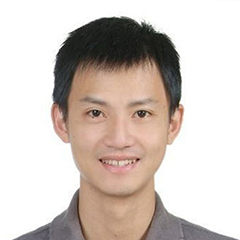|

Assistant Professor
電話:
+886 2 29809899 # 6317
電子郵件:
huangyc@mail.mcut.edu.tw
學歷:
PhD: Department of Materials Science and Engineering, National Taiwan University, Taipei, Taiwan (2010) Advisors: Prof. Wei-Fang Su
網站:
|
|
|
Department of Materials Engineering, Ming Chi University of Technology, New Taipei City, Taiwan.
Dr. Yu-Ching Huang is currently an assistance professor of the Department of Materials Engineering, Ming Chi University of Technology (MCUT) from 2018. He joined He joined the Institute of Nuclear Energy Research (INER) from 2010 to 2018, and he focuses on the development of large-area manufacture of the organic photovoltaics for indoor and commercial goal using spray coating, ink-jet printing and roll-to-roll (R2R) techniques in INER. His current research interests are in the area of understanding the fundamental mechanism of organic electronics, such as indoor organic photovoltaics, organic photodiode, perovskite solar cells and perovskite/Si tandem solar cells. In addition, he also studies the nanostructure and interfacial behavior of thin film by using the grazing-incident small-angle and wide-angle X-ray scattering (GIWAXS and GISAXS). Until now, Dr. Y. C. Huang has published nearly 60 peer-reviewed journal papers in a number of leading journals in materials science, including Nature Photonics, Environment & Energy Science, Advanced Materials, ACS Nano, Journal of Materials Chemistry A, ACS Applied Materials & Interfaces, Nanoscale, Solar Energy Materials and Solar Cells, etc. His publications were cited over 2100 times with an H-index of 25. He also has been awarded 6 US patents and 13 Taiwanese patents.
|
研究興趣
Prof. Y. C. Huang’s research topics are in the commercial process and application of organic and perovskite electronics. Currently, he focuses on how to improve the performance of these organic electronics, such as photovoltaics and photodetectors. His interests include:
-
Solution-processed organic and perovskite materials and devices
-
Organic photovoltaics for indoor application
-
Transparent conductive metal oxides for perovskite/Si tandem solar cells
-
Near-infrared organic photodiodes for bioelectronics
-
Nanostructure and interfacial interaction of thin film using synchrotron radiation
精選期刊:
-
Pei-Huan Lee, Bo-Ting Li, Chia-Feng Lee, Zhi-Hao Huang, Yu-Ching Huang*, and Wei-Fang Su**, “High-efficiency perovskite solar cell using cobalt doped nickel oxide hole transport layer fabricated by NIR process,” Solar Energy Materials and Solar Cell, vol. 208, pp. 110352 (2020).
-
Pei-Huan Lee, Bo-Ting Li, Chia-Feng Lee, Zhi-Hao Huang, Yu-Ching Huang*, and Wei-Fang Su**, “High-efficiency perovskite solar cell using cobalt doped nickel oxide hole transport layer fabricated by NIR process,” Solar Energy Materials and Solar Cell, vol. 208, pp. 110352 (2020). Link: https://www.sciencedirect.com/science/article/pii/S0927024819306786 2. Chuang-Yi Liao, Yao Chen, Chun-Chieh Lee, Gang Wang Nai-Wei Teng, Chia-Hao Lee, Wei-Long Li, Yu-Kuang Chen, Chia-Hua Li, Hsiuan-Lin Ho, Phoebe Huei-Shuan Tan, Binghao Wang, Yu-Ching Huang, Ryan M. Young, Michael R. Wasielewski, Tobin J. Marks*, Yi-Ming Chang*, and Antonio Facchetti*, “Processing Strategies for an Organic Photovoltaic Module with Over 10% Efficiency”, Joule, vol. 4, pp. 189-206 (2020)
-
Yu-Ching Huang*, Wei-Shun Liu, Cheng-Si Tsao* and Leeyih Wang*, “Mechanistic insights into the effect of polymer regioregularity on the thermal stability of polymer solar cells,” ACS Appl. Mater. Interfaces, vol. 11, pp.40310-40319 (2019).
-
Yu-Ching Huang*, Chia-Feng Li, Zhi-Hao Huang, Po-Hung Liu, and Cheng-Si Tsao*, “Rapid and sheet-to-sheet slot-die coating manufacture of highly efficient perovskite solar cells processed under ambient air,” Sol. Energy, vol. 177, pp.255-261 (2019)
-
Hung-Yu Lin, Chien-Yu Chen, Bo-Wei Hsu, Yu-Lun Cheng, Wei-Lun Tsai, Yu-Ching Huang, Cheng-Si Tsao, and Hao-Wu Lin*, “Efficient cesium lead halide perovskite solar cells through alternative thousand-layer rapid deposition,” Adv. Funct. Mater., vol. 29, pp.1905163 (2019)
|

